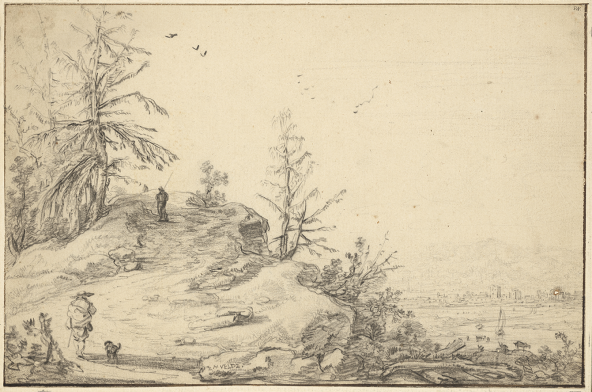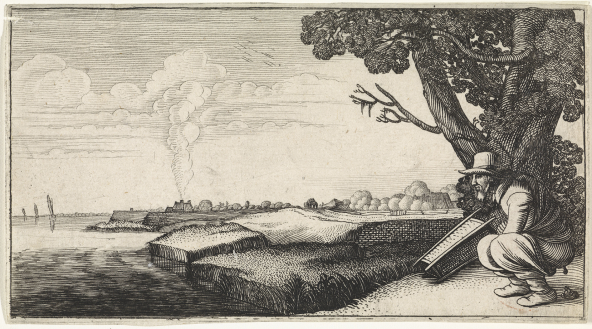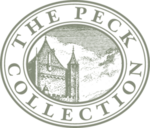Choose a background colour
Esaias van de Velde, Dutch, 1587-1630
:
River Landscape on a Hill, 1620
Pen in brown ink on paper; framing lines in brown ink.
5 7⁄16 × 7 7⁄16 in. (13.8 × 18.9 cm)
Recto, lower left, in pen, signed and dated by the artist, V.VELDE 1620.
- Chain Lines:
- Vertical, 20 – 23 mm.
- Watermark:
- Cross with Entwined Serpent (cropped at bottom).
- Provenance:
Fürst von Schaumburg-Lippe, Bückeburg, Schloss Bückeburg; Curt Otto, c. 1880 – 1929, Leipzig (Lugt 611c); his sale, C. G. Boerner, Leipzig, 7 November 1929, lot 144; I. Q. van Regteren Altena, 1899 – 1980, Amsterdam (Lugt 4617, stamp on verso); his sale, Part IV, Christie’s, Amsterdam, 13 May 2015, lot 201; Sheldon and Leena Peck, Boston (Lugt 3847); gift to the Ackland Art Museum, inv. no. 2017.1.87.
- Literature/Exhibitions:
Keyes 1984, 243, no. D94, pl. 93.
- Ackland Catalogue:
- 2017.1.87
Esaias van de Velde employed a low horizon line and a nearly blank sky to convey a sense of open space and great distance in these naturalistic scenes of old trees and country roads. In the 1610s, together with other artists active in Haarlem, Van de Velde ushered in a new style of landscape art that focused on local surroundings rather than the vast panoramic, and often fantastical, views made by previous generations.
Here, a herder guides his flock up a hill set beside a river or estuary. In the lower left foreground, a man squats to relieve himself while his dog waits patiently, a humorous addition commonly found in earlier Netherlandish art. Apparently, the figure either did not see the large outhouse perched on the ledge further up the path, or he could not be bothered to use it.
Together with other artists working in Haarlem in the 1610s, Esaias van de Velde developed a new style of landscape that would predominate in seventeenth-century Dutch art.1
For Van de Velde and these artists, the local surroundings served as their most important source of inspiration instead of the vast dramatic sweeps of mountainous (and often fantastical) views preferred by previous generations. This drawing offers precisely one such view, with a herder marching his fl ock up a hill along what appears to be the embankment of a river or estuary. This is somewhat hilly terrain, not to be found in the province of Holland itself. It could have been inspired by travels farther afi eld, such as along the Scheldt estuary to the south, or simply a view conjured from his imagination. He used nearly the same compositional formula for a black chalk drawing in the Louvre probably made a few years later Fig. 10.1.2

Esaias van de Velde, Path Leading Up a Wooded Rise, c. 1624. Black chalk on paper, 220 × 334 mm. Paris, Musée du Louvre, inv. no. 23.099.
RMN-Grand Palais/Art Resource, NY
Van de Velde often sought subtle perspectival effects in his landscapes, such as those produced by the nearly blank sky in the Peck drawing. It is remarkably effective in suggesting deep distance past the rise in the hill, an aspect aided by the careful placement of the water and distant hills in the lower right to generate a sense of an unseen horizon behind the main composition.
Esaias often signed his drawings but did not always date them. His inclusion of the year on this work proves significant because it is his only known drawing dated 1620. The vast majority of his pen and ink drawings date to the 1610s, a decade when he primarily worked in Haarlem. After moving to The Hague in 1618, he enthusiastically took to exploring the use of black chalk for his drawings.3
Only a few of his sheets in pen and ink are thought to date to this later period after he left Haarlem, including another work in the Peck Collection.4
Esaias added a humorous touch to this image with the figure of a man defecating in the lower left corner while his canine companion waits patiently by his side. The motif of depicting a figure engaged in such activity has a long tradition in Netherlandish art.5
According to Karel van Mander, Joachim Patinir (1480 – 1524) garnered the nickname kakker (pooper) for his habit of placing a small figure relieving himself in his landscape paintings.6
The motif is relatively rare in Esaias’s works, although he used it on at least one other occasion.7
The Haarlem artist Jan van de Velde II (1593 – 1641), who was perhaps Esaias’s distant cousin, turned the motif into the primary subject of a print from a series treating the rigors of travel Fig. 10.2.8

Jan van de Velde II, Landscape with a Defecating Man. Etching and engraving on paper, 88 × 160 mm. Amsterdam, Rijksmuseum, inv. no. rp-p-ob-15.316.
Rijksmuseum, Amsterdam
Particularly amusing in Esaias’s drawing is the presence of the outhouse perched on the ledge at the top of the rise. Apparently, the traveler completely missed its presence — which would have been opportune — or he simply could not be bothered to reach it.
End Notes
For Esaias van de Velde’s life and works, see Keyes 1984. The literature regarding the new modes of landscape being produced in Haarlem at the time is large, but see especially Freedberg 1980; London 1986; Amsterdam, Boston & Philadelphia 1986 – 87; Levesque 1996; Leeflang 1997; and Gibson 2000.
Keyes 1984, 277, no. D200, pl. 168.
Ackland Art Museum, inv. no. 2017.1.86.
See Riboulliault 2016, who posits an art-theoretical aspect to this motif, the artist “regurgitating” nature.
Van Mander, Lives, vol. 1, 134.
See Keyes 1984, 252, no. D119, pl. 106.
Hollstein, vols. 33 – 34, no. 130.
